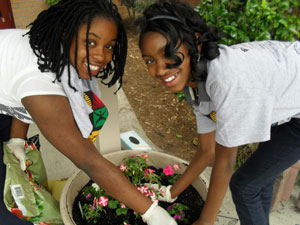
Equality In Environmental Education For Minority Students
When the 1963 March on Washington for Jobs and Freedom happened 50 years ago to highlight political and social injustice towards African Americans, there was no “Earth Day” and no environmental justice movement. It is ironic since Rachel Carson’s Silent Spring – the book credited with launching the environmental movement - was published on September 27, 1962, almost a full year before the March. And while the civil rights movement for racial equity that awakened from the 1963 March has widened to include a variety of people of color and issues, the environmental movement still struggles with its own diversity.
With Earth Day this month, once again there’s a focus in schools on how to close an apparent education gap within an environmental movement that has historically been perceived as a mostly white movement. But new research may have a solution that can help at least minority middle school students learn to close that gap.
The belief is that environmental education in children is critical to meet emerging environmental challenges worldwide. With the changing demographics in the U.S. educational system soon to make white students the minority, leveling the environmental literacy playing field now will do well to strength this environmental education movement. The problem has always been how to reach a new generation of kids of color the exhibit an ever widening diversity. As far back as October 1999, an Environmental Education and Training Partnership Resource Librarypublication tried to address the issue, noting: “We need to be ready to meet the needs of minority students and give these students of diverse backgrounds meaningful environmental education experiences. In order to do this, it is essential we are aware of each learner's unique background, are aware of differences in learning-styles, and include multi-cultural perspectives when we teach environmental education.”
Actually, researchers now feel it is less complicated.
A study from North Carolina State University has found that getting kids outdoors into natural ecosystems during environmental education programs can help minority middle school students close the gap. In fact, the research finds that minority students actually benefit more from such outdoor programs than white students for improving students’ “ecological knowledge, environmental attitudes and behavior.”
“This is one of the first studies on a broad scale to focus on environmental literacy, which is more than mastering facts,” said the study’s co-author Nils Peterson, associate professor of fisheries and wildlife in NC State’s College of Natural Resources.“Being environmentally literate means that students learn cognitive skills so that they can analyze and solve problems, and it involves environmental attitudes and behaviors as well.”
The study, “Environmental, Institutional, and Demographic Predictors of Environmental Literacy among Middle School Children,” published March 22 in PLOS ONE, used printed environmental education curricula and quality time outdoors among middle schools in North Carolina. The study did this while noting such things as teacher education level; student age, gender, and ethnicity; and the socio-economic status of the school.
But what surprised researchers was that “time outdoors seemed to impact African-American and Hispanic students more than Caucasian students, improving minority students’ ecological knowledge and cognitive skills, two measures of environmental literacy.”
 Specifically, those kids that only used printed environmental materials from sources like Project Learning Tree or Project WILD didn’t show much improvement when measuring their environmental literacy. But when those classroom materials were paired with quality time in the great outdoors, the students showed improvement in all the key components needed for good environmental literacy. “Our findings suggest ethnicity related disparities in [environmental literacy] levels may be mitigated by time spent in nature, especially among black and Hispanic students,” notes the study.
Specifically, those kids that only used printed environmental materials from sources like Project Learning Tree or Project WILD didn’t show much improvement when measuring their environmental literacy. But when those classroom materials were paired with quality time in the great outdoors, the students showed improvement in all the key components needed for good environmental literacy. “Our findings suggest ethnicity related disparities in [environmental literacy] levels may be mitigated by time spent in nature, especially among black and Hispanic students,” notes the study.
“We are interested in whether outdoor experiences can be part of a catch-up strategy that can help in narrowing the environmental literacy gap for minority students,” said the lead author of the study, NC State graduate student Kathryn Stevenson.
Outdoor environmental education is not new. Nationwide, “No Child Left Inside”initiatives have sprouted as a sort of back-to-nature movement to encourage environmental education in a number of states. The idea dates back to Last Child in the Woods: Saving Our Children From Nature-Deficit Disorder, a 2005 book by Richard Louv that sparked interest in enhancing environmental education by getting kids out in the wild.
Meanwhile, the researchers plan a follow-up to the study using the coast of North Carolina to measure middle school students’ grasp of one of the world’s biggest environmental issues: Climate change.
Hopefully, the students will all be packing their copies of Silent Spring.
